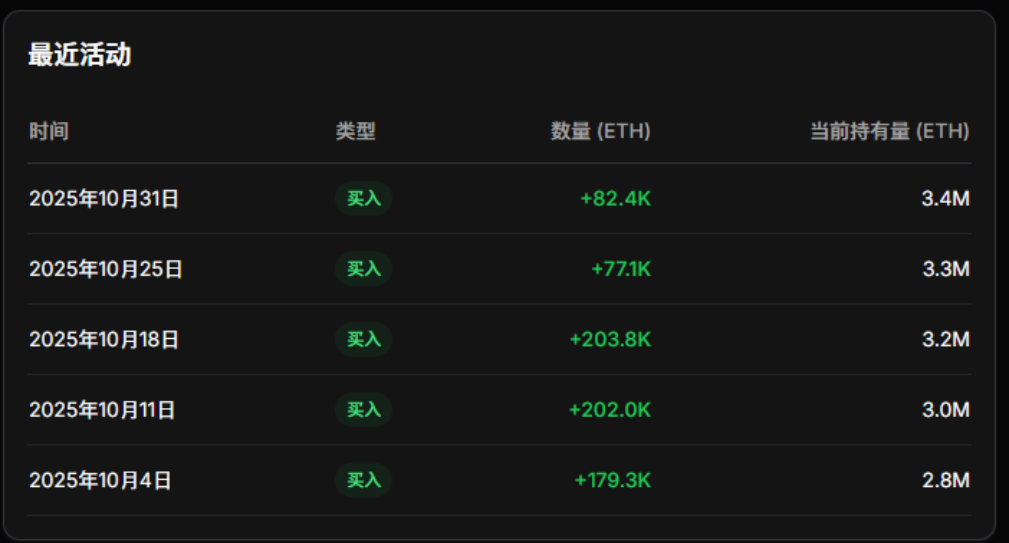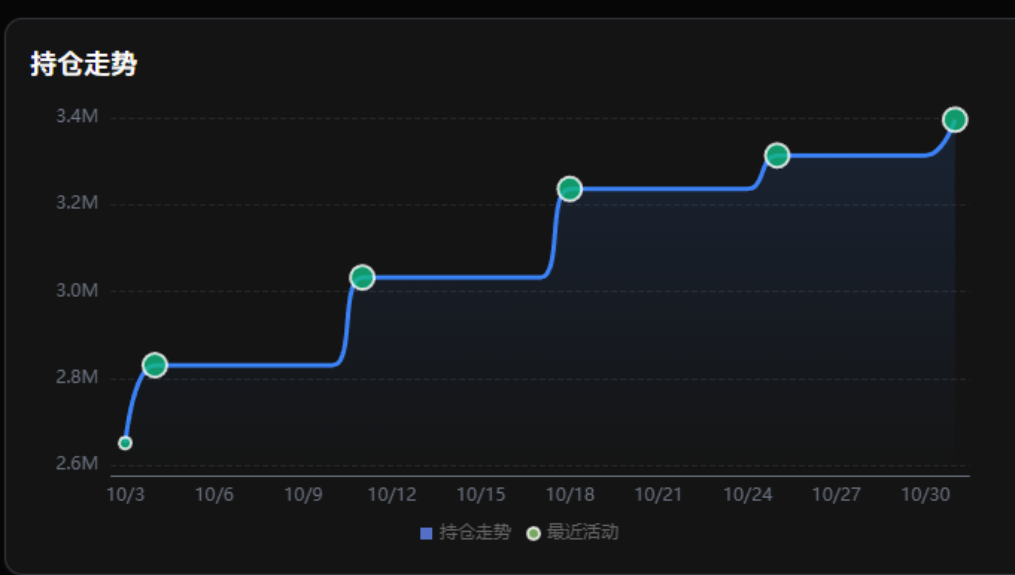35 days, from zero to world number one, BitMine's Ethereum treasury strategy is rewriting the rules for institutional participation in the crypto economy.
On July 1, 2025, BitMine's ETH holdings were still zero. Just 35 days later, this previously little-known bitcoin mining company held over 830,000 ETH, leaping to become the world's largest corporate holder of Ethereum.
By mid-August, BitMine's ETH holdings had increased to about 1.2 million, worth approximately $5.48 billion. This is not just a shift in corporate treasury strategy, but also the prelude to a wave of institutional capital entering the crypto world.

I. Strategic Shift: From Zero to the Largest Ethereum Whale
The speed of BitMine's rise is astonishing. On June 30, 2025, the company announced the launch of a $250 million private placement, officially shifting to an Ethereum treasury strategy.
● This move was endorsed by Wall Street heavyweights—Fundstrat founder Thomas Lee became chairman of the board, and former PayPal CEO Peter Thiel, as well as Ark Invest CEO Cathie Wood, followed up with investments.
● Under Thomas Lee's leadership, BitMine launched a textbook-level capital allocation operation. On July 14, the company announced it held over $500 million worth of ETH; just three days later, this figure doubled to $1 billion. By August 4, BitMine held 833,000 ETH, becoming the world's largest ETH treasury.
● BitMine's buying pace was precise and rapid. According to its disclosures, the company completed its first batch purchase of about 150,000 ETH in the first week; in the second week, total holdings surpassed 560,000; by the third week, cumulative holdings exceeded 830,000.
This highly efficient capital allocation was made possible by a full suite of tools provided by Galaxy Digital, including "OTC structure design + on-chain settlement + custody," enabling BitMine to efficiently absorb large amounts of ETH without causing dramatic price fluctuations.


II. Treasury Strategy: A New Model for Digital Asset Custody
The DAT (Digital Asset Treasury) model adopted by BitMine is redefining the way companies create value.
Business Model
BitMine's business model centers on cryptocurrency mining and strategic reserves, forming a "technology-driven + asset allocation + ecosystem synergy" trinity structure:
● Immersion Cooling Mining: Operates bitcoin mines using oil immersion cooling technology, reducing energy consumption by over 30% compared to traditional air cooling and extending miner lifespan. The mines are located in Texas, USA, and Trinidad and Tobago. In 2025, BitMine rapidly expanded computing power by leasing 800 Antminer S-19 miners, with mining revenue up 571% year-on-year.
● Mining as a Service (MaaS): Provides enterprises with one-stop mining solutions, including miner leasing, power management, and financial support, lowering the entry barrier for institutions. For example, in cooperation with Luxor Technology, BitMine launched a computing power leasing smart contract to automate revenue distribution.
● Ethereum Strategic Reserve: In 2025, BitMine launched its Ethereum treasury strategy with $250 million in private financing, aiming to become one of the world's largest publicly listed ETH holders. Funds are used to directly purchase ETH and participate in staking (with an annualized yield of about 5%), while also exploring DeFi protocol layer yields.
● Computing Power Financialization: Turns computing power into tradable financial products, offering synthetic mining contracts so investors can share mining profits without owning hardware.
Profit Model
Crypto-related profits mainly come from four major paths:
● Bitcoin Mining Revenue: Produces bitcoin from its own mines. In May 2025, mining revenue accounted for 68% of the company's total revenue. Miner hosting services charge a monthly fee based on computing power, at a rate of $0.08/TH/day.
● Ethereum Appreciation and Staking Revenue: As of July 17, 2025, BitMine held 300,657 ETH (worth over $1 billion), achieving asset appreciation through price fluctuations. At the same time, staking part of the ETH yields about 5% annualized return, with Q2 2025 staking income reaching $1.2 million.
● Private Financing and Token Issuance: In 2025, BitMine completed a $250 million private placement to increase ETH holdings and plans to issue stablecoins pegged to physical assets (such as photovoltaic power plant income rights), creating a closed loop for on-chain financing and payments.
● Computing Power Contract Sharing: Synthetic mining contracts charge a 20% management fee on profits. In Q1 2025, revenue from this business grew 340% year-on-year, becoming the second-largest profit source.
Impact of the Profit Model
● Improved financial risk resistance: Bitcoin and Ethereum reserves account for 72% of the company's total assets, and the asset-liability ratio in Q2 2025 is only 12%, significantly lower than the industry average. ETH staking income provides stable cash flow, reducing reliance on mining revenue.
● Benchmark for technological innovation: Immersion cooling technology has been widely imitated in the industry. By 2025, this solution accounted for 35% of new mines in the US, boosting bitcoin mining energy efficiency by 22%.
● Release of ecosystem synergy value: By increasing ETH holdings, BitMine deeply participates in the Ethereum ecosystem. For example, in cooperation with Kraken, it developed DeFi liquidity pools, driving USDT trading volume on the ETH chain up by 47%.
Impact on Cryptocurrencies
Bitcoin (BTC):
● Computing Power Market Pricing Power: BitMine's computing power accounts for 0.8% of the global bitcoin network, and its miner deployment strategy directly affects mining difficulty adjustments. In June 2025, computing power expansion led to an 11% month-on-month increase in network difficulty, temporarily suppressing small and medium miners' profits.
● Market Confidence Transmission: Continuous bitcoin accumulation is seen as a signal of institutional entry. In Q2 2025, BitMine's bitcoin holdings accounted for 0.0007% of total circulating supply, setting an example for stabilizing short-term price fluctuations.
Ethereum (ETH):
● Reshaping Supply and Demand Structure: BitMine plans to acquire and stake 5% of Ethereum's supply (about 6.03 million ETH), which may reduce circulation and push up staking yields. In July 2025, the ETH staking rate rose from 18% at the beginning of the year to 22%.
● Ecosystem Development Accelerator: By participating in DeFi protocols (such as Uniswap V4 liquidity pools) and Layer2 scaling projects (such as Caldera), BitMine has boosted Ethereum's transaction throughput by 15% and daily active addresses by 28%.
III. Why Choose Ethereum?
Among the many cryptocurrencies, BitMine's firm choice of Ethereum reflects its deep judgment on the future development of blockchain infrastructure.
● Thomas Lee has publicly stated that Ethereum will become the infrastructure for the financialization and AI era, and that the current market price is far below its real potential. With Wall Street moving on-chain, Ethereum is expected to become one of the most important macro trends of the next decade.
● Compared to bitcoin, Ethereum offers more diverse sources of income. Companies can obtain stable returns through Ethereum's proof-of-stake mechanism by staking.
● As Thomas Lee said: "This essentially enables these companies to operate like infrastructure providers, with stable sources of income."
● Ethereum's network effect is also its core advantage. Ethereum has become the core infrastructure of digital finance, carrying the vast majority of DeFi applications, NFT transactions, and enterprise-level blockchain applications. As traditional financial institutions accelerate "on-chain," Ethereum's network value will continue to grow.
IV. Strategic Execution: Maximizing ETH Holdings Per Share
● BitMine's core business logic is simple and powerful—maximize ETH holdings per share. In a digital asset bull market, the density of coin holdings determines the leverage of shareholder returns, and this metric has replaced traditional earnings per share as the key performance indicator.
The company continuously increases ETH per share through multiple strategies:
● Premium issuance strategy is one of the core methods. When the share price trades at a premium to the net asset value of ETH, the company issues new shares.
For example, BitMine's latest plan is to raise $20 billion to buy ETH—assuming the net asset value per share is $100 but the share price is $120, the company issues shares to obtain $120 in cash to buy an equivalent amount of ETH, raising the per-share ETH value from $100 to about $110, thus increasing value.
● Innovation in derivative tools is another approach. The company issues convertible bonds and other equity-linked securities to monetize the dual volatility of stocks and ETH for additional capital.
● In addition, reinvesting staking returns also provides sustained growth momentum. Ethereum's PoS mechanism offers BitMine yield opportunities not available to bitcoin DAT companies.
V. Market Impact: Leading the Corporate Ethereum Hoarding Trend
BitMine's success is sparking imitation. More and more listed companies are beginning to regard Ethereum as a core reserve asset.
● Currently, large enterprises hold about $7.6 billion in ETH, with plans to increase to $30.4 billion—about three times the current amount.
In this corporate hoarding wave, several companies stand out:
● SharpLink Gaming holds 521,939 ETH. Since shifting to Ethereum reserves, its share price has risen 400%, and it plans to invest up to $5 billion in the future.
● BTCS owns 70,000 ETH and plans to further increase holdings through $2 billion in financing.
● Bit Digital, after a $67 million additional offering, holds over 120,000 ETH and has fully transformed into an Ethereum asset management company.
● Large-scale corporate accumulation of ETH is profoundly changing the market's supply and demand structure. According to Crypto Rover data, as of June 20, 2025, 38 corporate entities had raised their Ethereum strategic reserves to over $3 billion.
This large-scale institutional accumulation is seen as a strong bullish signal for the crypto market in 2025.
VI. Challenges and Risks: Uncertainties on the Road Ahead
Although BitMine's strategy has achieved remarkable results so far, the road ahead is not all smooth.
● Price volatility risk is one of the biggest challenges. Renowned gold supporter Peter Schiff once predicted that Ethereum would fall below $3,000 and pointed out that it had dropped nearly 40% from its August high, erasing all gains for 2025.
● Regulatory uncertainty is also a potential risk. As companies hold large amounts of crypto assets, regulators may strengthen oversight and restrictions on such behavior.
● In addition, technology risk cannot be ignored. Although the Ethereum network is constantly being upgraded, its ecosystem still faces scalability and security challenges.
Despite these risks, BitMine's billionaire backers—Peter Thiel's Founders Fund, Cathie Wood's ARK Invest, and Tom Lee—still show strong confidence, providing continued capital and credibility support for the company's strategy.
On October 19, 2025, market data showed that during the "10.11 crash," BitMine not only did not reduce its holdings but instead went all in, accumulating nearly 380,000 ETH worth about $1.48 billion.While many investors were panic selling, BitMine was increasing its position against the trend.
In the mines of Texas, miners immersed in coolant continue to operate day and night, while the screen displaying ETH holdings has quietly surpassed 1.2 million. This is a transformation from industrial capital to financial capital—BitMine is no longer just a mining company; it is becoming the core hub for institutional capital flowing into the Ethereum ecosystem.




